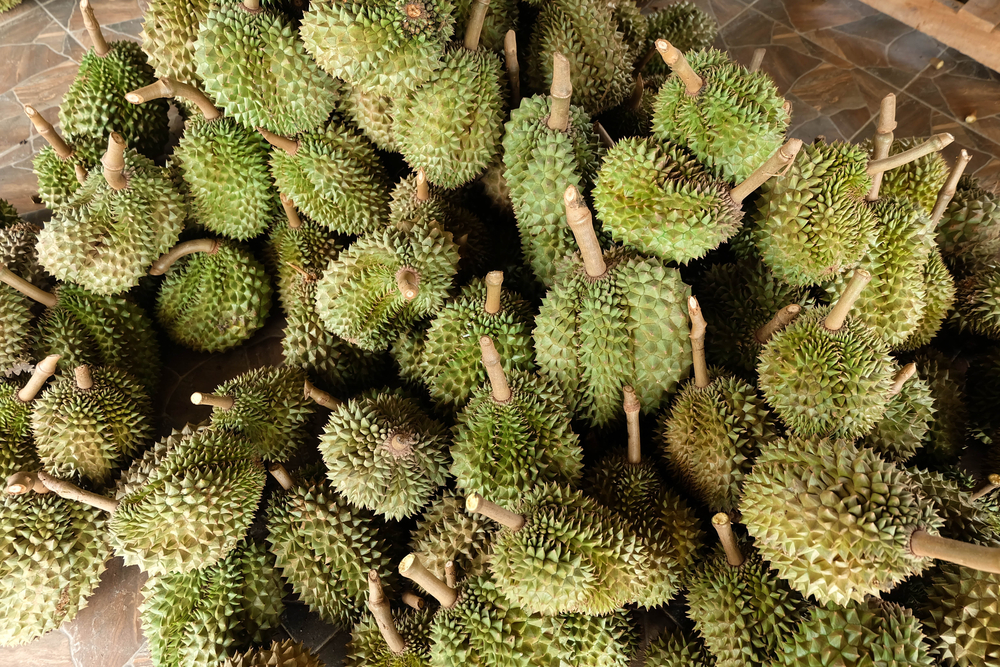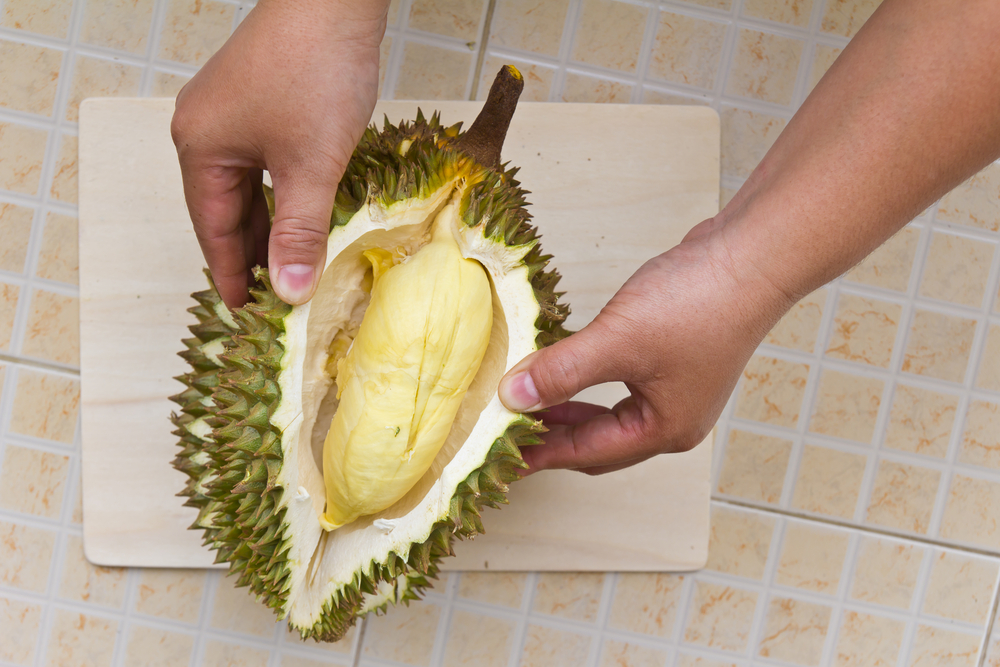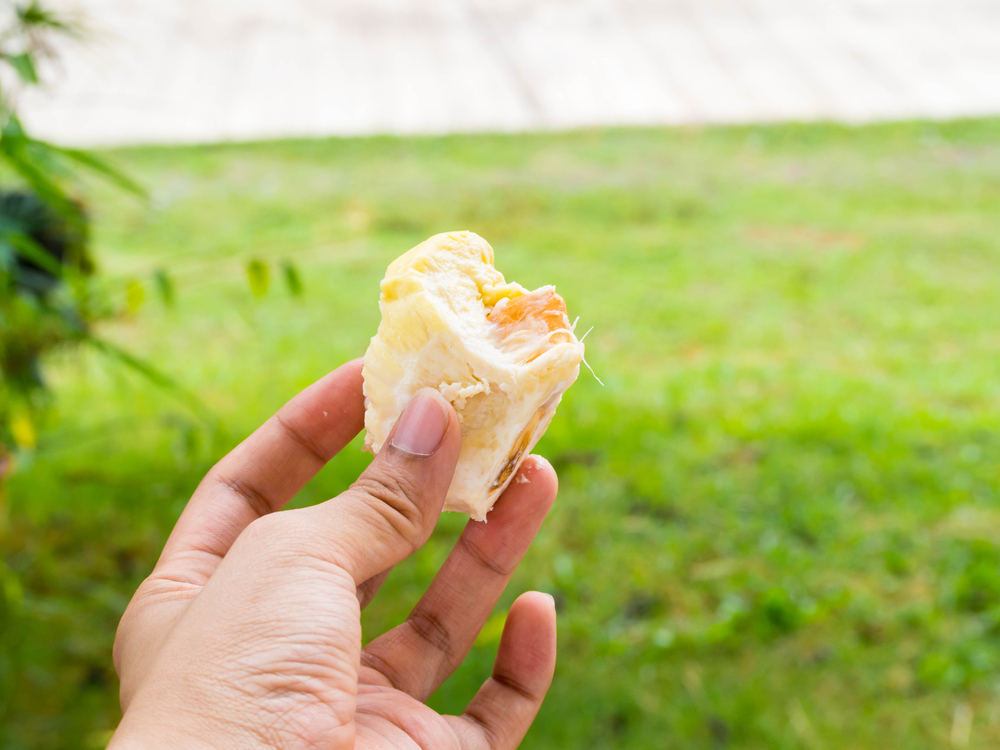Dare to durian: An expat’s encounter with the King of Fruits


Before coming to Malaysia, I’m not even sure I knew what a durian was. But when I moved to Kuala Lumpur, it certainly did not take long before the controversial fruit became a topic of daily conversation.
In fact, durian was popping up everywhere; it had its own rock candy at Sticky, made an appearance on the Jimmy Kimmel show, and while deciding on a flavour at an ice cream outlet, another customer told me that I should try the durian variety as the server filled her order to the container’s brim.
I became curious about the fruit, not only because of the intriguing stories about its foul odour or bizarre texture, but I wanted to know why the durian was crowned Southeast Asia’s “king of fruits”.
Apparently, the nickname was given to the durian due to its large and spiky appearance, and because the fruit yields numerous health benefits. A study by the Queensland Primary Industries and Fisheries revealed the durian has some of the highest levels of fibre, folates and potassium of all fruits. According to the Smithsonian, traditional Asian medicine has also used the durian in anti-fever treatment and as an aphrodisiac, evoking the Indonesian saying “the durian falls and the sarong comes up.”
While its appearance and health benefits are just two reasons why the fruit gained the nickname ‘king of fruits’, I would personally say it’s also to do with the intimidation factor that the fruit shares with people in power. Needless to say, the durian is one scary-looking fruit.
The durian’s reputation among many westerners is one of foul taste, odd texture, and an odour that induces nose pinching reflexes. In fact, durian is banned in many hotels and public transportation systems in Malaysia and in other countries, and even most supermarkets refuse to sell the fruit.
“[Durian is] indescribable, something you will either love or despise… Your breath will smell as if you’ve been French-kissing your dead grandmother.”
– American celebrity chef, Anthony Bourdain
While some may be completely put off by the fruit, others can’t get enough. In 2004, as reported in the New Straits Times, Thailand’s Ministry of Public Health sent out a warning about safe consumption of durian following the deaths of two people within the same month.
The New Straits Times reported the first of the durian-related deaths was a man who was “known to drink a lot of alcohol” but was not drinking at the time he consumed the fruit. The second man who died after consumption of the fruit, suffered from diabetes but still overindulged in four durians.
Thailand’s Ministry of Public health, as reported in the New Straits Times, advised the consumption of no more than two durian segments per day, and, due to the high calorie content, people with high blood pressure or diabetes should be aware of the threat durian may pose to their health. Mixing the fruit with an alcoholic drink is also not advisable according to scientists at Japan’s Univeristy of Tsukuba, who discovered the high sulphur content in durians reduces the liver’s ability to breakdown alcohol – by up to 70 percent.
Considering all of this, perhaps a better nickname would be the ‘fruit of death’?
Nevertheless, eating – or at least trying – durian seems like a rite of passage when you move to Malaysia. So I decided to try the notorious fruit, and come to a conclusion of my own, which may or may not end up being a regrettable endeavour.
First impressions
As a native fruit in Malaysia, there are many types of durian available, each with its own distinctive characteristics. The flesh of durian can be any hue between pale yellow and orangey-red. Depending on which type of durian, they can also offer a sweet or bitter flavour, or bittersweet in the case of the Musang King, which is arguably one of the most popular varieties, as well as one of the most expensive.
Durians, whichever type you choose, are described as a spiky fruit, but I didn’t realised just how vicious one could be. Upon buying a durian, which is charged by weight, the street seller asked if we required a bag. I said yes; one to conceal the forbidden fruit and two so it didn’t look like I was carrying around the head of a mace. The spikes of the durian refused to be contained by the bag and pierced holes in the plastic. So naively, we decided to put the durian in my friend’s backpack.
Walking home, I said to my friend: “Is that the durian I can smell?” She replied: “No, it can’t be.”
But we were wrong. It was, in fact, the durian, which was now sweating in the layers of plastic bags we’d wrapped it in. Now while I wouldn’t go as far as saying the fruit smells disgusting, its fruity odour is incredibly obnoxious and intrusive. It leaves its scent wherever it goes, lingering even when the fruit itself is no longer present.
A look inside and the taste test
The smell is one thing, but one look inside the durian and its already less appealing than its exterior. In fact, the inside of the durian reminds me of a womb, and the segments look like those alien egg sacs that you always see hanging in laboratories in sci-fi films.
The flesh itself looks relatively harmless. In fact, the creamy yellow flesh looks just like vanilla custard. However, as soon as the durian flavour hit my taste buds, to my friend’s amusement, I knew I’d made a horrible mistake. It may have looked like custard, but it certainly did not taste like it.
Even after I forced another three pieces of the fruit into my mouth, I struggled to define the flavour because it tastes like no other singular fruit. While I still can’t put my finger on it, and I’m refusing to taste a fourth bite, there’s definitely fruity notes. However, to me, fruit is something fresh and delicious, and the durian was neither of those things. It tastes how I imagine fruit marinated in onion juice would taste, and then left out in the sun for a few days to rot.
In fact, I felt like it was a concoction for contestants on shows like ‘I’m a Celebrity Get Me Out of Here’ or some other show where they torture people with horrible foods for the viewer’s amusement. The worst part is, that just like its odour, the aftertaste lingers… for hours.
While the durian may never be making its way back into my mouth, there’s a lot of love for the fruit here in Malaysia and other Southeast Asian countries, such as Thailand and Singapore. Maybe that’s simply why it’s the King of Fruits – people worship it.
What are your thoughts on durian? Do you love it or hate it?
"ExpatGo welcomes and encourages comments, input, and divergent opinions. However, we kindly request that you use suitable language in your comments, and refrain from any sort of personal attack, hate speech, or disparaging rhetoric. Comments not in line with this are subject to removal from the site. "





















Best taste ever!!!
My first experience with durian was in Kuala Lumpur when I bought chocolate-covered durian. I opened the box; and the strong smell of this fruit filled the room. I tried to taste it, but couldn’t. After that I noticed how popular the durian was in Malaysia.
Soo delicious love it , miss it …DURIAN king of fruits
I love durians
Age old adage. – White people’s bucket list. o.O
Absolutely love (sort Musang King)
Try eating it with dark chocolate powder. That’ll mask some of the smell and it’s a great complement to the taste.
Great descriptions – made me laugh. Well done eating 3 bites, I couldn’t do that.